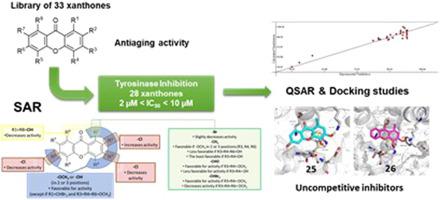Bioorganic & Medicinal Chemistry ( IF 3.3 ) Pub Date : 2020-11-19 , DOI: 10.1016/j.bmc.2020.115873 G P Rosa 1 , A Palmeira 2 , D I S P Resende 2 , I F Almeida 3 , A Kane-Pagès 4 , M C Barreto 1 , E Sousa 2 , M M M Pinto 2

|
The human skin is constantly exposed to external factors that affect its integrity, UV radiation being one of the main stress factors. The repeated exposure to this radiation leads to increased production of Reactive Oxygen Species (ROS) which activate a series of processes involved in photoaging. Excessive UV exposure also exacerbates melanin production leading to a variety of pigmentation disorders. Xanthones are reported to exhibit properties that prevent deleterious effects of UV exposure and high levels of ROS in the organism, so in this work a wide library of xanthones with different patterns of substitution was synthesized and tested for their inhibitory activity against the skin enzymes tyrosinase, elastase, collagenase and hyaluronidase, many of which were evaluated for the first time. Most of the compounds were tyrosinase inhibitors, with the best one (xanthone 27) presenting an IC50 of 1.9 µM, which is approximately 6 times lower than the IC50 of the positive control kojic acid. Concerning the other enzymes, only one compound presented IC50 lower than 150 µM in elastase inhibition (xanthone 14 = 91.8 µM) and none in collagenase and hyaluronidase inhibition.
A QSAR model for tyrosinase inhibitory activity was built using six molecular descriptors, with a partial negative surface area descriptor and the relative number of oxygen atoms being positively contributing to the tyrosinase inhibitory activity. Docking using AutoDock Vina shows that all the tested compounds have more affinity to mushroom tyrosinase than kojic acid. Docking results implied that the tyrosinase inhibitory mechanisms of xanthonic derivatives are attributed to an allosteric interaction. Taken together, these data suggest that xanthones might be useful scaffolds for the development of new and promising candidates for the treatment of pigmentation-related disorders and for skin whitening cosmetic products.
中文翻译:

抑制黑素生成的氧杂蒽酮:分子对接和 QSAR 研究以了解其抗酪氨酸酶活性
人体皮肤不断暴露于影响其完整性的外部因素中,紫外线辐射是主要的压力因素之一。反复暴露于这种辐射会导致活性氧 (ROS) 的产生增加,活性氧物质 (ROS) 会激活一系列涉及光老化的过程。过度的紫外线照射也会加剧黑色素的产生,导致各种色素沉着障碍。据报道,氧杂蒽酮具有防止紫外线照射和高水平 ROS 在生物体中的有害影响的特性,因此在这项工作中,合成了具有不同取代模式的氧杂蒽酮库,并测试了它们对皮肤酶酪氨酸酶的抑制活性,弹性蛋白酶、胶原酶和透明质酸酶,其中许多是首次评估。大多数化合物是酪氨酸酶抑制剂,27 ) 的 IC 50为 1.9 µM,比阳性对照曲酸的 IC 50低约 6 倍。关于其他酶,只有一种化合物在弹性蛋白酶抑制中的IC 50低于 150 µM(呫吨酮14 = 91.8 µM),在胶原酶和透明质酸酶抑制中没有。
使用六个分子描述符建立酪氨酸酶抑制活性的 QSAR 模型,部分负表面积描述符和氧原子的相对数量对酪氨酸酶抑制活性有积极贡献。使用 AutoDock Vina 进行对接表明,所有测试的化合物对蘑菇酪氨酸酶的亲和力都高于曲酸。对接结果暗示黄酮衍生物的酪氨酸酶抑制机制归因于变构相互作用。综上所述,这些数据表明氧杂蒽酮可能是有用的支架,可用于开发治疗色素沉着相关疾病和皮肤美白化妆品的新候选药物。











































 京公网安备 11010802027423号
京公网安备 11010802027423号